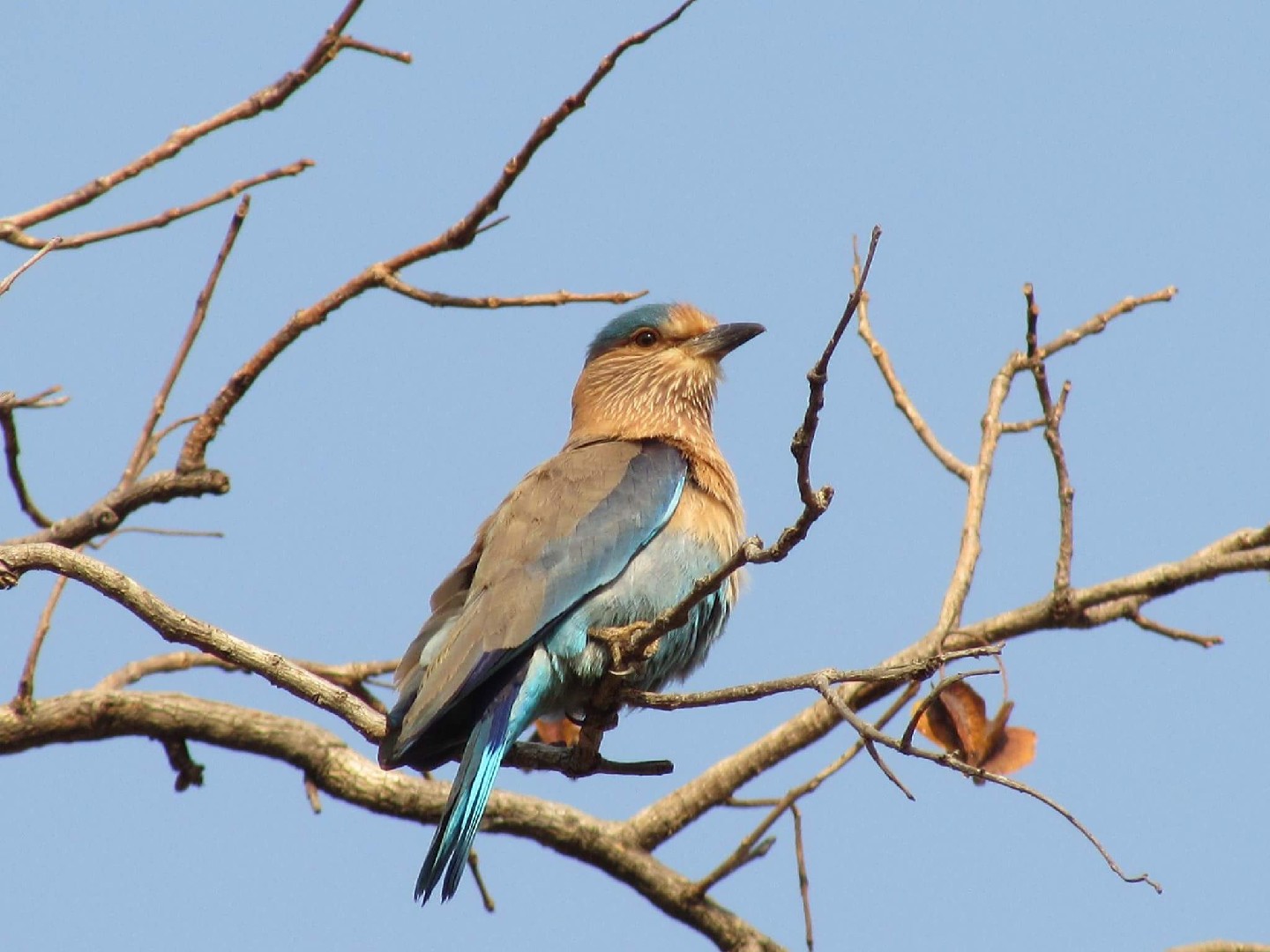Indian Roller
A species of Typical Rollers Scientific name : Coracias benghalensis Genus : Typical Rollers
Indian Roller, A species of Typical Rollers
Botanical name: Coracias benghalensis
Genus: Typical Rollers
Content
Description People often ask General Info
 Photo By Divyansh8824 , used under CC-BY-SA-4.0 /Cropped and compressed from original
Photo By Divyansh8824 , used under CC-BY-SA-4.0 /Cropped and compressed from original Description
The Indian roller is a stocky bird about 26–27 cm long and can only be confused within its range with the migratory European roller. The breast is brownish and not blue as in the European Roller. The crown and vent are blue. The primaries are deep purplish blue with a band of pale blue. The tail is sky blue with a terminal band of Prussian blue and the central feathers are dull green. The neck and throat are purplish lilac with white shaft streaks. The bare patch around the eye is ochre in colour. The three forward toes are united at the base. Rollers have a long and compressed bill with a curved upper edge and a hooked tip. The nostril is long and exposed and there are long rictal bristles at the base of the bill. Three subspecies are usually recognized. The nominate form is found from western Asia (Iraq, Arabia) east across the Indian Subcontinent, and within India north of the Vindhyas mountain ranges. The subspecies indicus is found in peninsular India and Sri Lanka. The southern form has a darker reddish collar on the hind neck which is missing in the nominate form. The Indochinese roller of eastern India and Southeast Asia (Thailand, Myanmar, Indochina) has been suggested as a full species, but within the Indian region, it is seen to intergrade with benghalensis. The Indochinese roller is darker, larger and has a purplish brown and unstreaked face and breast. It has underwing coverts in a deeper shade of blue. 
Size
34 cm
Colors
Brown
Gray
Blue
Purple
Life Expectancy
8.9 years
Nest Placement
Cavity
Feeding Habits
Indian Roller feeds on insects, spiders, scorpions, small snakes, and amphibians, favoring beetles and grasshoppers. It gleans, hunts on the ground, and captures prey mid-air, sometimes guided by artificial light.
Habitat
Indian Roller is primarily found in the broad regions of Southwestern and Southern Asia, inhabiting landscapes such as cultivated farmlands, open forests, and grasslands. These birds adapt well to human presence, often seen around villages, urban parks, and gardens. Typically, their habitats are at elevations up to 1500 meters, with some reaching higher altitudes post-breeding.
Dite type
Insectivorous
People often ask
General Info
Feeding Habits
Bird food type
Behavior
Indian rollers are often seen perched on prominent bare trees or wires. They descend to the ground to capture their prey which may include insects, spiders, scorpions, small snakes and amphibians. Fires attract them and they will also follow tractors for disturbed invertebrates. In agricultural habitats in southern India, they have been found at densities of about 50 birds per km. They perch mainly on 3–10-metre high perches and feed mostly on ground insects. Nearly 50% of their prey are beetles and 25% made up by grasshoppers and crickets. The feeding behaviour of this roller and habitat usage are very similar to that of the black drongo. During summer, they may also feed late in the evening and make use of artificial lights and feed on insects attracted to them. They are attracted to swarms of winged termites, and as many as 40 birds have been seen to perch on a 70-metre stretch of electric wires. Its habit of feeding near roadsides sometimes results in collisions with traffic. A decline in the numbers of these birds seen along roadsides in northern India has been noted. A study on roosting behaviour found that immediately after waking up, the birds spend a few minutes preening followed by flying around their roosting sites. Favoured perches include electric or telegraphic wires. They have also been observed perching in trees and shrubs. Rollers tend mostly at a heights of 3–9 m height from where they forage for ground insects. They may also use taller perches and obtain insects from the upper canopy of trees. The display of this bird is an aerobatic display, with the twists and turns that give the Coraciidae its English name of "rollers". The breeding season is March to June, slightly earlier in southern India. Displays when perched include bill-up displays, bowing, allopreening, wing drooping and tail fanning. Holes created by woodpeckers or wood boring insects in palms are favoured for nesting in some areas. Nest cavities may also be made by tearing open rotten tree trunks or in cavities in building. The cavity is usually unlined and is made up mainly of debris from the wood. The normal clutch consists of about 3–5 eggs. The eggs are white and broad oval or nearly spherical. Both sexes incubate the eggs for about 17 to 19 days. The young fledge and leave the nest after about a month. Nearly 80% of the eggs hatch and fledge. The call of the Indian roller is a harsh crow-like chack sound. It also makes a variety of other sounds, including metallic boink calls. It is especially vociferous during the breeding season. The bird bathes in open water by plunge-diving into it, a behaviour often interpreted as fishing. But it may occasionally attempt fishing from water. Blood parasites Leucocytozoon of the family Plasmodiidae have been noted in the lung tissues. Parasitic helminth worms Hadjelia truncata and Synhimantus spiralis were recorded as well. 
Distribution Area
The Indian roller is distributed across Asia, from Iraq and United Arab Emirates in south-western Asia through the Indian Subcontinent, including Sri Lanka, Lakshadweep islands and Maldive Islands. Its main habitat includes cultivated areas, thin forest and grassland. 
Species Status
Not globally threatened.